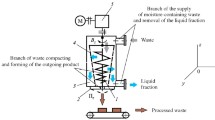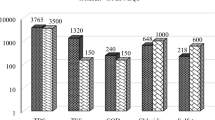Abstract
Dewatering is a major process in a wide range of manufacturing industries. One of the most commonly used technologies for dewatering is the screw press. The optimized setting of the screw press increases the amount of recycled water for further production. Additionally, it reduces waste disposal costs by lowering the weight of discharged sludge. In this paper, we used the design of experiments to determine the parameters that affect the dryness of the final waste. Our study showed the significant parameters were the pump speed, the screw rotation speed, and the properties of inflowing sludge. Using the significant factors, a regression model was developed to predict the dryness of the final waste. Then, the regression model was used as the objective function of an optimization model to find the optimal settings of the screw press that maximizes the dryness of sludge. The optimum setting of the screw press increased the dryness of sludge by 2.3%, saving 387 metric tons of water annually. The financial effects of improving the dryness of the sludge leaving the screw press were calculated showing a reduction in disposal costs and reduction in water usage costs because the water extracted from the sludge is recycled. Further investigations showed that the amounts and types of chemicals used to pretreatment the inflowing sludge to the head box can affect the dryness of the sludge leaving the screw press.



Similar content being viewed by others
References
Egenes TH, Helle T (1992) Flow characteristics and water removal from pulp suspensions in a screw press. J Pulp Paper Sci 18(3):J93–J99
Egenes TH, Helle T (1992) Transport and drainage processes in a screw press, as affected by material characteristics. In: Annual Meeting-Technical Section Canadian Pulp and Paper Association, vol 78, pp B173–B173
Egenes TH, Helle T, Bendiksen PB, Hegstad G (1995) Removal of water and contaminants from ONP stocks in a screw press : lowering feed consistency increases removal of fines components. Pulp Paper Canada 96(10):40–46
Meyer T, Amin P, Allen DG, Tran H (Oct. 2018) Dewatering of pulp and paper mill biosludge and primary sludge. J Environ Chem Eng 6(5):6317–6321. https://doi.org/10.1016/j.jece.2018.09.037
Bredeson DK (1983) Mechanical oil extraction. J Am Oil Chem Soc 60(2):211–213. https://doi.org/10.1007/BF02543484
Pradhan RC, Mishra S, Naik SN, Bhatnagar N, Vijay VK (2011) Oil expression from Jatropha seeds using a screw press expeller. Biosyst Eng 109(2):158–166. https://doi.org/10.1016/j.biosystemseng.2011.02.012
Chapuis A, Blin J, Carré P, Lecomte D (2014) Separation efficiency and energy consumption of oil expression using a screw-press: the case of Jatropha curcas L. seeds. Ind Crop Prod 52:752–761. https://doi.org/10.1016/j.indcrop.2013.11.046
Indartono YS, Heriawan H, Kartika IA (2019) Innovative and flexible single screw press for the oil extraction of Calophyllum seeds. Res Agric Eng 65(3):91–97, Oct. 2019. https://doi.org/10.17221/85/2018-RAE
Fangueiro D, Senbayran M, Trindade H, Chadwick D (2008) Cattle slurry treatment by screw press separation and chemically enhanced settling: effect on greenhouse gas emissions after land spreading and grass yield. Bioresour Technol 99(15):7132–7142. https://doi.org/10.1016/j.biortech.2007.12.069
Yan Q, Miazek K, Grande PM, Domínguez de María P, Leitner W, Modigell M (2014) Mechanical pretreatment in a screw press affecting chemical pulping of Lignocellulosic biomass. Energy Fuel 28(11):6981–6987. https://doi.org/10.1021/ef501706w
Martínez ML, Marín MA, Salgado Faller CM, Revol J, Penci MC, Ribotta PD (2012) Chia (Salvia hispanica L.) oil extraction: study of processing parameters. LWT Food Sci Technol 47(1):78–82. https://doi.org/10.1016/j.lwt.2011.12.032
Savoire R, Lanoisellé J-L, Vorobiev E (2013) Mechanical continuous oil expression from oilseeds: a review. Food Bioprocess Technol 6(1):1–16. https://doi.org/10.1007/s11947-012-0947-x
Rombaut N, Savoire R, Thomasset B, Castello J, Van Hecke E, Lanoisellé J-L (2015) Optimization of oil yield and oil total phenolic content during grape seed cold screw pressing. Ind Crop Prod 63:26–33. https://doi.org/10.1016/j.indcrop.2014.10.001
El idrissi B, Loranger É, Lanouette R, Bousquet JP, Martinez M (2019) Dewatering parameters in a screw press and their influence on the screw press outputs. Chem Eng Res Des 152:300–308. https://doi.org/10.1016/j.cherd.2019.10.001
Sall J, Stephens ML, Lehman A, Loring S (2017) JMP start statistics: a guide to statistics and data analysis using JMP. SAS Institute, 6th Edition
FKC Co. LTD (2015) FKC Operation and maintenance manual for FKC sludge dewatering equipment, Pot Angeles, WA
Montgomery DC (2017) Design and analysis of experiments. John Wiley & Sons
Berry WD, Feldman S, Dr SF (1985) Multiple regression in practice. SAGE
Kumanan S, Jesuthanam CP, Ashok Kumar R (2008) Application of multiple regression and adaptive neuro fuzzy inference system for the prediction of surface roughness. Int J Adv Manuf Technol 35(7):778–788. https://doi.org/10.1007/s00170-006-0755-4
Zhao H, Han L, Liu Y, Liu X (2021) Modelling and interaction analysis of the self-pierce riveting process using regression analysis and FEA. Int J Adv Manuf Technol 113(1):159–176. https://doi.org/10.1007/s00170-020-06519-9
Kuo C-C, Pietras S (2010) Applying regression analysis to improve dyeing process quality: a case study. Int J Adv Manuf Technol 49(1):357–368. https://doi.org/10.1007/s00170-009-2381-4
Moore DS, McCabe GP, Craig BA (2016) Introduction to the Practice of Statistics, ninth edition. W. H. Freeman, New York
Availability of data and material
Available in the “data deposition” file attached.
Code availability
Available in the “data deposition” file attached.
Author information
Authors and Affiliations
Contributions
All the authors contributed significantly to the work with the order provided.
Corresponding author
Ethics declarations
Conflict of interest
The authors declare no competing interests.
Additional information
Publisher’s note
Springer Nature remains neutral with regard to jurisdictional claims in published maps and institutional affiliations.
Supplementary information
ESM 1
(DOCX 19 kb)
Rights and permissions
About this article
Cite this article
Mirzaei, S., Shen, L. Water disposal minimization of a screw press in the tissue manufacturing process. Int J Adv Manuf Technol 115, 2659–2667 (2021). https://doi.org/10.1007/s00170-021-07247-4
Received:
Accepted:
Published:
Issue Date:
DOI: https://doi.org/10.1007/s00170-021-07247-4




